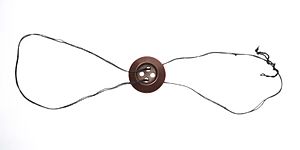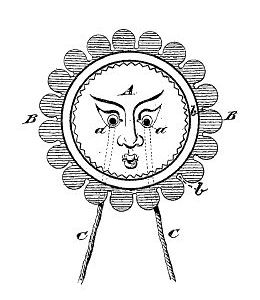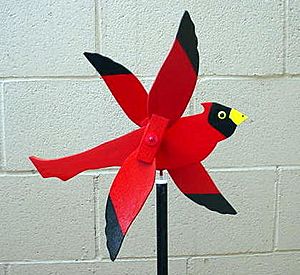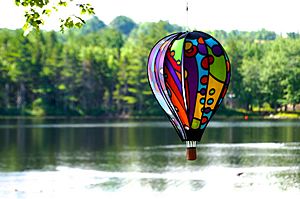Whirligig facts for kids
A whirligig is a cool object that spins or whirls! It always has at least one part that goes round and round. You might also hear them called a pinwheel, a buzzer, a funny weather-vane, a gee-haw, or just a whirly.
Most whirligigs are powered by the wind. But some can be spun by hand, by rubbing them, or even by a motor. People often use them as moving art in their gardens. Some special whirligigs can even send sounds and vibrations into the ground to scare away animals like gophers or moles!
Contents
Types of Whirligigs
Whirligigs can be put into four main groups: those that use a button, those that use friction, those that use string, and those that are powered by the wind.
Button Whirligigs
Button whirligigs are also known as button spinners or buzzers. They are the oldest type of whirligig we know about! All you need to make one is a piece of clay or bone and a strip of animal hide. People in Native American cultures were playing with their own versions of this toy way back in 500 BC. Many kids growing up during the Great Depression in the southern United States remember using a button or a coin with a string as their main spinning toy.
Button whirligigs are simple toys. You put a string through two holes in a button, make loops at each end, and then pull the loops with both hands. This makes the string twist and untwist, causing the button to spin very fast. You can often find button whirligigs in craft shops and souvenir stores in the southern Appalachian Mountains today.
Buzzers
Buzzers are a type of button whirligig that make a sound. The sound can change depending on how fast the button is spinning and how tight the string is. A buzzer is usually made by putting a string through two holes of a large button. It's a common and easy toy to make!
A buzzer (sometimes called a buzz or button-on-a-string) is an old device used for special ceremonies and as a toy. You make it by putting an object in the middle of a string. Then you wind up the string while holding the ends still. You make the object spin by pulling and releasing the string. As the object whirls around, it makes a buzzing or humming sound, which is how it got its name.
Native Americans used buzzers as toys. They also used them in ceremonies, sometimes to call for the wind. Early Native American buzzers were made from wood, bone, or stone. Some of them date back to at least 500 BC.
| North American Buzzers | ||
|---|---|---|
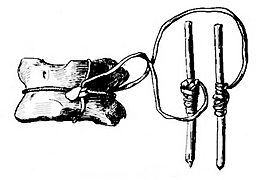 |
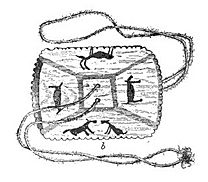 |
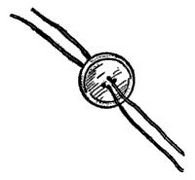 |
|
1912 "A Buzzer of Bone" |
1892 "Buzz Toy" |
1916 "Whirligig Made from a Large Button" |
Friction and String Whirligigs
String-powered whirligigs need you to wrap a string around a stick or shaft. Then you pull the string to make the whirligig move. These types of whirligigs are very old. The bamboo-copter (or bamboo butterfly) was invented in China around 400 BC. While the first ones didn't use string to launch their propeller, later Chinese versions did. Some of the first pictures of whirligigs are string-powered ones found in old tapestries from the Middle Ages.
Friction whirligigs, also called gee-haws, work differently. You rub a stick against a notched shaft. This rubbing causes vibrations that travel along the shaft and make a propeller at the end spin. The movement is a lot like rubbing sticks together to start a fire. Friction whirligigs are another popular item you can find in craft and souvenir shops in the Appalachian Mountains.
Wind-Driven Whirligigs
A wind-driven whirligig takes the energy from the wind and turns it into spinning motion. Sometimes it's a simple spin, and other times it powers a more complex machine that makes repeated movements or sounds. The wind simply pushes on a part of the whirligig, and it starts to turn.
The simplest and most common example of a wind-driven whirligig is the pinwheel. Pinwheels show us something important about whirligigs: the size and shape of their blades. Pinwheels have large, cupped blades. This design helps them catch a lot of air, allowing them to spin very fast even when the wind is not blowing hard.
If a whirligig has bigger blades, it catches more air. This makes it spin up to its fastest speed more quickly. On the other hand, if the blades are thin or short, they don't catch as much air. This means you need stronger wind to get the whirligig started and keep it spinning. Whirligigs come in all sorts of sizes and designs. The most common type has two blades and doesn't have complex moving parts, like the classic Cardinal with wings shown in the picture.



